Features and methods of grafting cherries
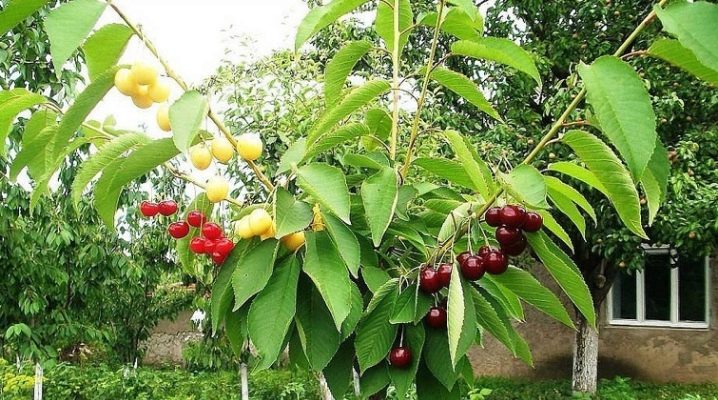
Grafting cherries to other fruit trees is in great demand among gardeners. With this procedure, you can improve the condition of the plant and get a tasty, rich harvest. However, manipulation requires special knowledge, so first you need to familiarize yourself with its advantages and disadvantages, as well as study the rules of vaccination in order to get a quality result.
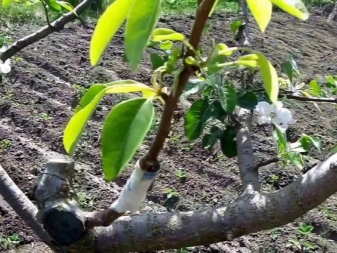
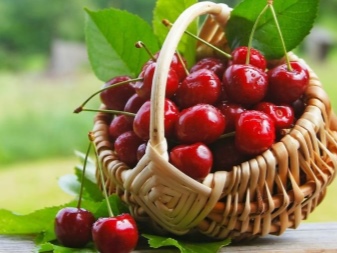
Advantages and Disadvantages of Vaccination
One of the benefits of grafting a tree is restoration of overgrown plants, improvement of fruit taste and adaptation of southern varieties to cool climates... If you follow all the recommendations of experts, you can strengthen the immune system of cherries, and it will be more resistant to pests and diseases. Thanks to this method of reproduction, inhabitants of cold regions can grow tasty fruits. Despite the complexity of manipulation, it can be of immense benefit if done correctly.
Grafting allows you to breed other varieties by crossing cherries with plums, cherry plums and some other fruit trees, while the quality of the native variety does not deteriorate in any way, and this is important. If the plant has mechanical damage, it can be restored with a scion. Another advantage of vaccination is that it provides an opportunity to shift the harvest time, which experienced professionals actively use. This period can be extended even up to one and a half months. As for the shortcomings, and they also exist, it is important to take them into account. There is no guarantee that the graft will take root, therefore, it is most often recommended to harvest a large number of cuttings. With a lack of experience, you can harm the plant, and if the maternal is lost, it will not be possible to restore it. The new branch does not affect the quality of the stock, so the manipulation will have to be carried out several times. At the same time, it is necessary to provide high-quality thorough care, monitor the condition of the tree, take into account weather conditions, since the immunity of the garden is too weak.
Many novice gardeners are thinking about whether cherries can be grafted onto bird cherry. Experts say that there will be a low survival rate due to different juices.
Practice shows that the berries are small and lose their pronounced taste, moreover, they can be tart. This means that you need to graft a fruit tree to certain species and varieties in order to get the desired result.
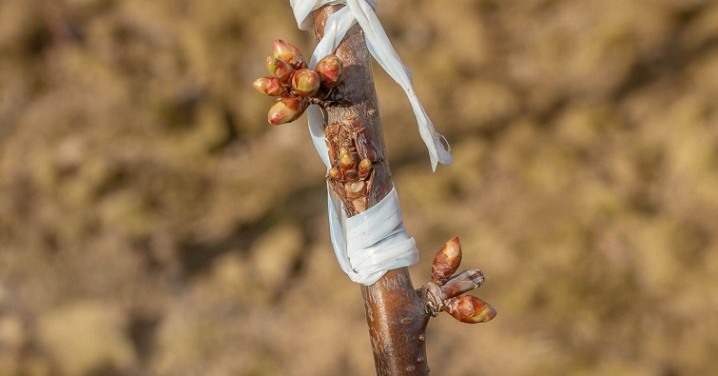
Timing
Time is of the essence, it is important to understand when exactly to graft fruit trees in order to achieve this goal. It all depends on the area in which the garden is grown, since the climate in the middle lane differs from the southern or northern part of the country. In each region, trees have a different period of active sap flow, if it is a warm climate, work can begin at the end of March, and April is suitable for the Central zone in Russia. The main condition is the absence of frost, the temperature should not fall below 3 degrees Celsius. Experts recommend testing for frost resistance, for this it is enough to cut off a branch and inspect the place of damage - if it darkens quickly, spring manipulation will not work.
If you do the procedure in the summer, the renewal begins in the first week of June, if the region is cool, it is better to wait until the middle of the month.For a couple of days, the stock should be watered abundantly, the cuttings should be soaked in a mixture with a biostimulant. If you are interested in fall grafting, it is important to consider that it is the most problematic, especially if you are new to the field. In warm and mild climates, temperature drops are insignificant, so plant rejuvenation can be carried out from September to October. Sweet cherry is a capricious crop that requires special conditions.
Despite this, following the basic rules will allow you to quickly achieve results, the main thing is to calculate the deadline, use special tools and follow the instructions.
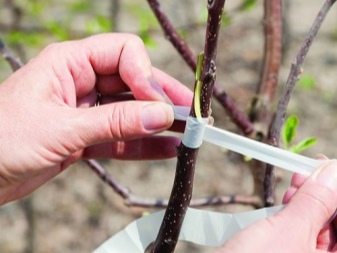
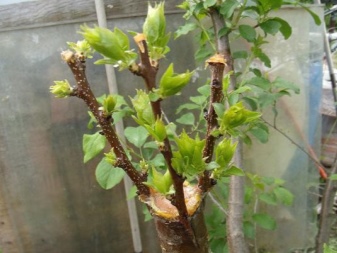
What can you vaccinate on?
Cherry grafting can be on a certain fruit tree species, so it is important to study this issue for a start. The rootstock plant should be chosen carefully. Sweet cherries can be grafted onto cherries, this will improve the taste of the harvest, so if you are not satisfied with the result, you can use this option. You can harvest the fruits as early as next year, which has been proven in practice. Cherry plum and plum are also suitable for such manipulations, because they are stone fruit trees.
It should be noted that one of the main benefits is plant strengthening, especially if the garden is located close to groundwater. As for cherries, it takes root well with cherries, besides, the tree will become more resistant to climatic changes and withstand harsh winters. Bird cherry is an excellent rootstock for grafting, as it is a strong crop that rarely suffers from diseases and withstands high berry fertility. The only thing that is important to consider is that during this manipulation, the fruits will be unusual, the taste is more close to bird cherry, but outwardly they completely resemble cherry.
Vaccination on the turn is equally popular, especially if you want to try different varieties of cherry plum. With the right procedure, the harvest will be successful and rich. Experts do not recommend grafting cherries to an apple or mountain ash, they are incompatible. The pear belongs to the category of pome fruits, so it also cannot be an ideal option for grafting. Professionals are studying vaccination techniques in nurseries, where all the necessary conditions have been created for this.
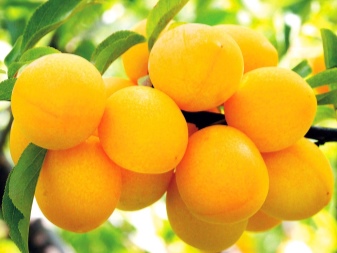

Preparation
Pest prevention plays an important role, and this does not depend on whether it is a summer vaccine or a spring one. Every couple of weeks, the weakened tree must be treated with insecticides. If electrical tape has been removed from the branches, they need to be protected. Harvesting of cuttings in the southern parts of the country begins in early December before the onset of frost, in the middle lane this is resorted to in late autumn. They need to be stored in a cool place, such as a cellar or shed.
A mixture of sawdust, peat and sand is placed in a box and slightly moistened, after which the scion is sent there and covered to protect it from light. If there is no such room, you can use an ordinary refrigerator, the cuttings are well preserved in such cold conditions, each branch must be wrapped with wet gauze, covered with a cloth and polyethylene. The material should not dry out or be too wet, as the wood will freeze. A stock is a plant on which a cutting will be grafted; this is a young tree that is already adapted to the climate of a particular region. The best choice would be a culture up to 10 years old, so the process will be much faster. A tree shoot acts as a graft, which is planted. Cuttings are harvested in the fall, and grafting takes place in the spring. The length of each should be up to 40 cm, the diameter of the branches is 5 cm. These can be shoots 1 year old with buds of growth. For the manipulation to be successful, it is important to follow certain rules.
One of these is the use of clean tools and gloves. The cuts must not be touched; only use a sharp knife to avoid leaving cracks, notches or irregularities.It is advisable that the stalk after grafting remains motionless, so the strapping must be tight. A garden pitch is used for putty, after a couple of weeks you need to check whether the scion has taken root, this is evidenced by shoots that will begin to appear from the buds.
It is important to monitor for pests and ensure quality watering.
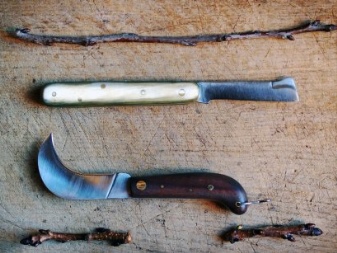
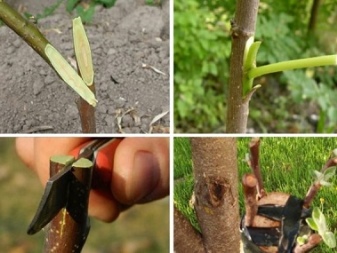
The ways
Your attention is offered instructions on different methods of grafting sweet cherries, regardless of which region you live in, be it the Moscow region or the southern regions. If everything is done correctly in the fall, closer to May, you can choose one of the presented methods, each of them has its own characteristics that are important to study.
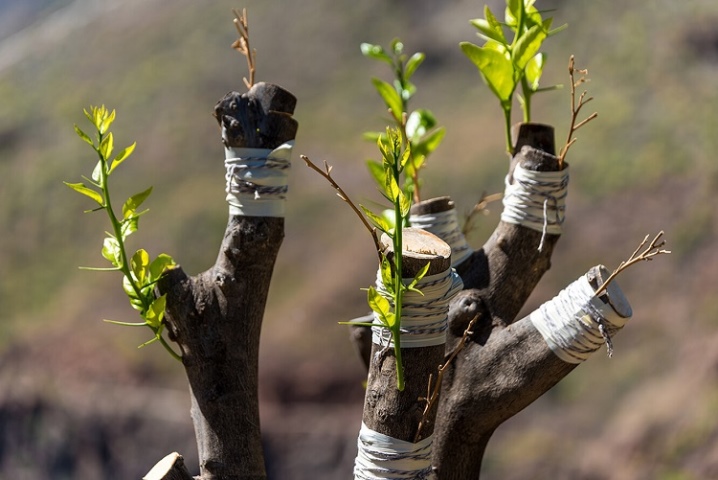
Side cut
The cutting should be made at a 30-degree angle, the end is trimmed to a wedge state. It must be inserted from the side, having previously cut the bark and stem of the stock. The green layers should be combined, then the scion is tightly fixed on the trunk, and the open places are processed with pitch. It is important to insulate this damaged area, you can use a bag or cling film. After 4 weeks, you will need to check how much the stalk has taken root, the formed buds will tell about this.
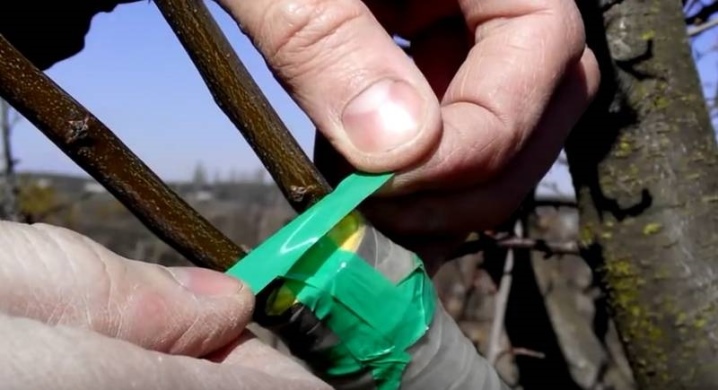
Copulation
This method is in great demand, you will need to combine the stem with the trunk, making sure that both parts are of the same diameter, so that one whole is formed. Oblique cuts are made both on the scion and on the rootstock, you can fix it with electrical tape. Specialists make splits in the slices to join them. After 2 weeks, the bag can be removed.
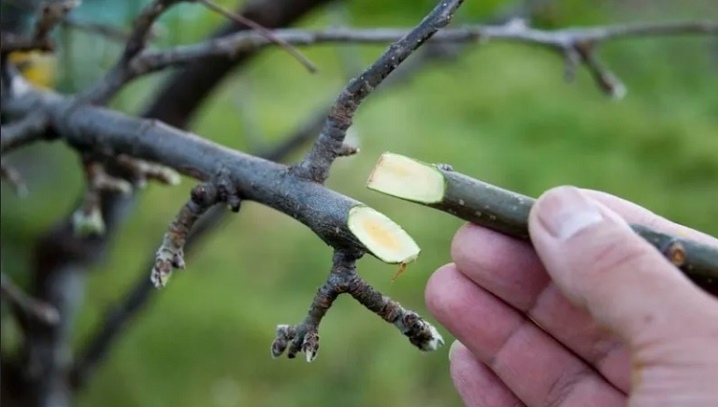
Into the cleft
This method is suitable when the tree trunk is much thicker than the grafted branch. The cuts should be even, an incision is made in the center at a depth of 5 cm, where the cutting is inserted. Make sure that the parts are tightly connected to each other, then secure with material and cover the sections with garden pitch, at the finish line, the stalk is wrapped in a plastic bag.
The check should be carried out after 3-4 weeks, if the buds are swollen and blossomed, then everything was done correctly.
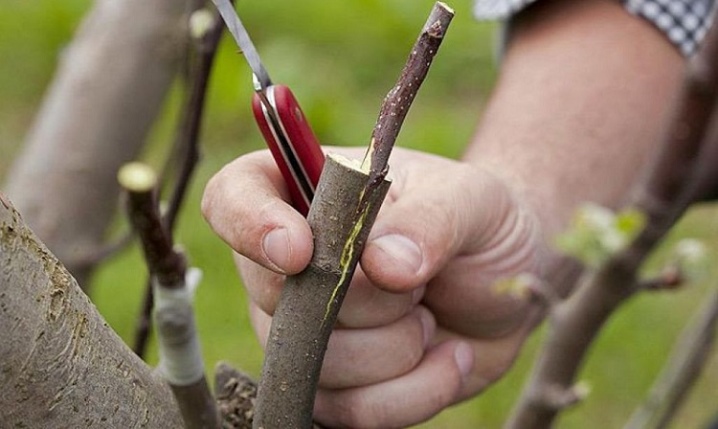
For the bark
This method is intended in cases where there is a strong sap flow. The method is as follows - an even cut is made on the branch of the stock, it is cleaned and a stalk is inserted there, cut along the side. In order for the wound to grow quickly, the vaccine can be done from several sides at once. The graft should take root in 2 weeks.
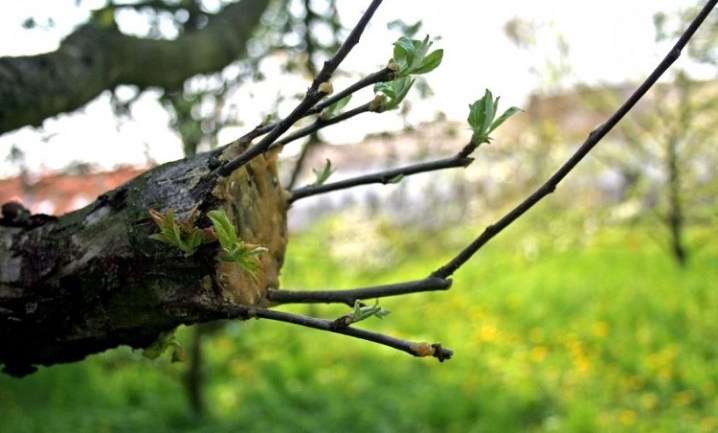
Budding
Here you need to plant a separate bud, not a stalk. It is imperative to prevent it from drying out, so after removal it should be immediately placed on a damp material. The bark is not peeled off, a T-shaped incision is enough, and the graft is inserted there, it is important to make sure that there is no free space left.
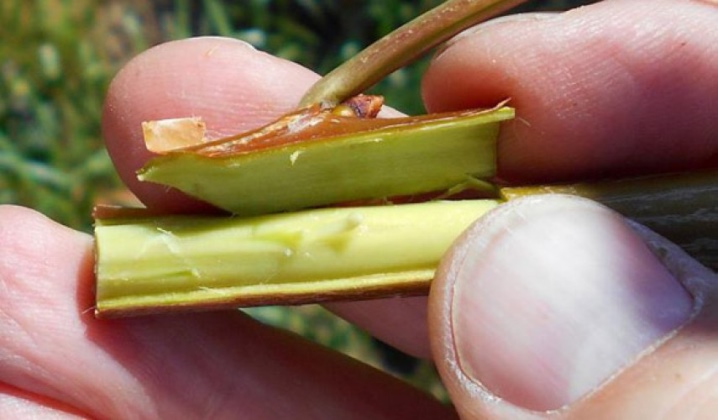
Corner cut
This method differs little from splitting. The prepared end of the cutting is inserted into the cut-out wedge, the cut should be exactly horizontal, go 6 mm from the top and 2 mm from the bottom, the height should not exceed 5 cm. The selected branch should match in parameters and be fixed with insulating tape.
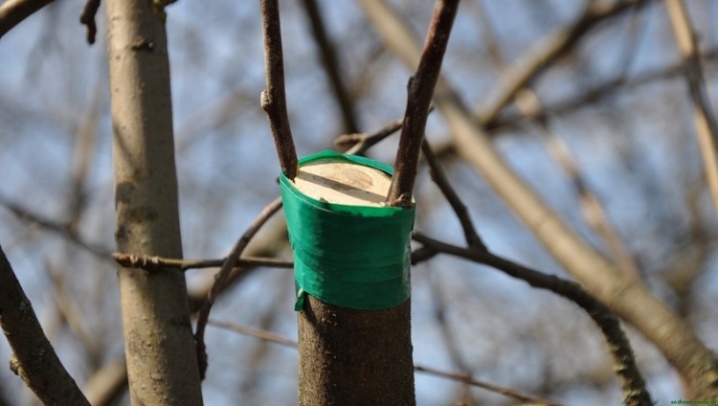
Follow-up care
Since the cherry has undergone a serious operation, it must recover, and in this it can be helped. Watering the tree should be done every week. Before the onset of flowering, it is important to apply root dressing, the same applies to the season of fruit setting. If new shoots have appeared on the rootstock, they must be removed, otherwise they will begin to take all the juices of the culture for themselves and stop the development of the tree.
It is recommended to carry out regular inspections to check the tightness of the film. If buds appear on the scion, the protective polyethylene can be removed so that the plant continues to develop. The next spring, the shoots on the scion need to be cut off, this will form a neat crown. Three years after inoculation, fatty branches are removed, which grow at an acute angle and along the trunk. Using such simple guidelines, you will be satisfied with the result.
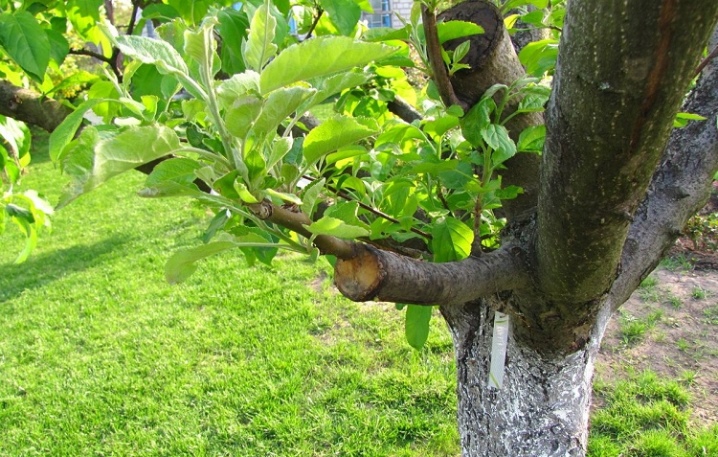






The comment was sent successfully.